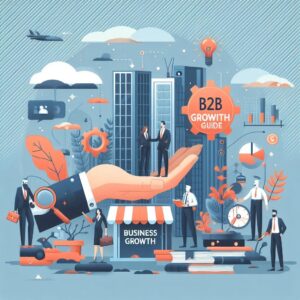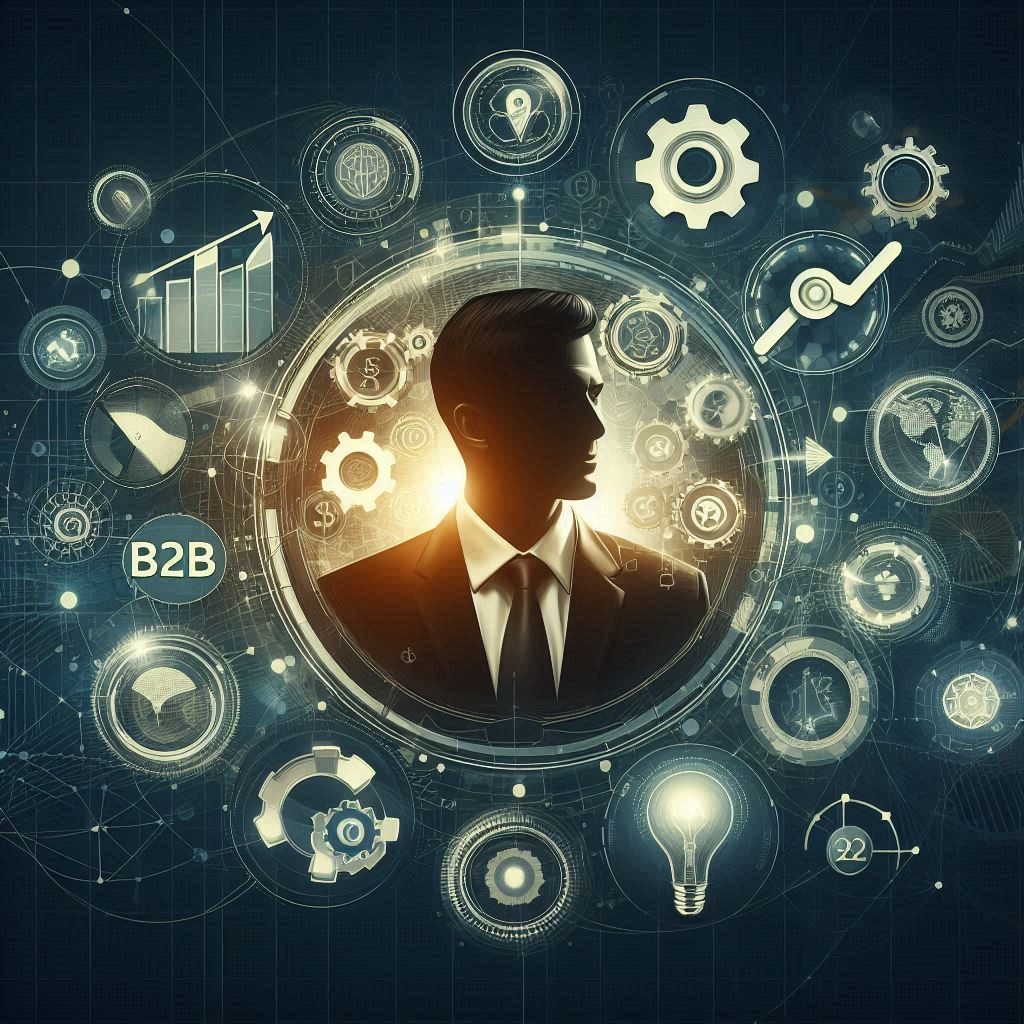1. Introduction to B2B
Definition of B2B
What is B2B or Business-to-Business (B2B)? B2B is describes transactions between companies, where businesses serve as both buyers and suppliers. Unlike Business-to-Consumer (B2C) relationships, which target individual customers, B2B focuses on fulfilling the professional and operational needs of other businesses. Examples include a steel supplier selling to automobile manufacturers or a tech firm providing cybersecurity solutions for financial institutions. In B2B, both parties aim for mutual benefits that enhance each company’s capacity to serve its market.Importance of B2B in the Modern Economy
 B2B interactions are fundamental to global economies, forming the backbone of industries like manufacturing, retail, IT, and logistics. They fuel the productivity and efficiency of these sectors by providing essential raw materials, services, and solutions, thus helping companies remain competitive and innovative. Digital commerce, big data, and artificial intelligence are increasingly integrated into B2B operations, adding immense value and allowing companies to refine their approach to customer acquisition, supply chain management, and digital marketing.
B2B interactions are fundamental to global economies, forming the backbone of industries like manufacturing, retail, IT, and logistics. They fuel the productivity and efficiency of these sectors by providing essential raw materials, services, and solutions, thus helping companies remain competitive and innovative. Digital commerce, big data, and artificial intelligence are increasingly integrated into B2B operations, adding immense value and allowing companies to refine their approach to customer acquisition, supply chain management, and digital marketing.
Everything You Need To Know About Business Key Insights And Strategies For Success
B2B Market Overview
The global B2B market has grown exponentially, driven by rapid advancements in technology, digital commerce, and globalization. Key markets include:- Manufacturing: Involving raw material and machinery providers that enable mass production.
- Technology: Encompassing IT, software, cloud services, and digital infrastructure essential to modern businesses.
- Professional Services: Fields like accounting, marketing, consulting, and legal services that support various aspects of business management.
- Wholesale and Distribution: Bridging manufacturers with retailers or end-consumer sellers by managing large-scale product distribution.
Best 50 Project Management Tools For B2B Of 2025
2. Types of B2B Models
Manufacturers and Suppliers
Manufacturers form the foundation of the B2B supply chain by providing raw materials, components, or finished products to other companies for further production or integration. For instance, a semiconductor manufacturer may sell microchips to an electronics company, which then incorporates them into consumer devices.
Wholesalers and Distributors
Wholesalers purchase goods in bulk from manufacturers to distribute them to retailers or businesses at lower prices. Distributors act as intermediaries, helping manage logistics, inventory, and marketing on behalf of manufacturers, making it easier for products to reach broader markets. Food distributors, for example, supply to grocery chains and restaurants, enabling manufacturers to focus on production.Everything You Need To Know About Business Key Insights And Strategies For Success
Retail and E-Commerce B2B
Digital marketplaces like Alibaba, ThomasNet, and Amazon Business offer comprehensive B2B e-commerce platforms, providing businesses with easy access to goods, bulk ordering, and tailored pricing. This model streamlines transactions, improves market reach, and reduces overhead costs by allowing companies to connect and transact online.Service Providers
Service providers offer specialized services like marketing, consulting, IT support, and software development to help businesses optimize their operations. For example, a consulting firm may provide expertise in compliance for financial institutions, or a software company may deliver enterprise solutions for project management. These services allow companies to access skills or technologies they may not have in-house.Top 25 Enterprise Resource Planning Erp Software For B2B
3. B2B Sales and Marketing Strategies
 Lead Generation Techniques
Lead Generation Techniques
Effective lead generation is essential in B2B, with methods such as search engine optimization (SEO), pay-per-click (PPC) advertising, networking events, and trade shows attracting potential customers. High-quality content, like whitepapers and industry reports, and data-driven outreach through LinkedIn or email marketing are also essential for capturing qualified leads.
Sales Funnel & Buyer’s Journey
The B2B sales funnel is longer and more complex than B2C, requiring multiple touchpoints and a clear understanding of each stage in the buyer's journey. The buyer’s journey often spans awareness, consideration, decision-making, and post-sale phases, each necessitating tailored communication to engage stakeholders and address specific business needs.The Ultimate Guide To B2B Lead Generation
Content Marketing for B2B
Content marketing in B2B centers on educating potential customers and showcasing expertise. Case studies, blog posts, whitepapers, webinars, and research reports help establish credibility and nurture leads. A well-planned content strategy addresses common pain points, provides solutions, and builds trust throughout the sales process.Comprehensive Guide To Business To Business B2B Development
Account-Based Marketing (ABM)
ABM targets high-value accounts by creating highly personalized campaigns tailored to individual clients. This approach aligns marketing and sales efforts, focusing on building strong relationships with key accounts and addressing the unique challenges of each client.B2B Branding and Positioning
Effective branding differentiates a business from its competitors. A strong brand identity, clear value propositions, and strategic positioning highlight the company's expertise and reliability. This can be reinforced through consistent messaging across touchpoints, such as digital platforms, trade shows, and client meetings.All Types Of Software For B2B Businesses
4. Benefits of B2B Transactions
 Efficiency and Productivity
Efficiency and Productivity
B2B partnerships streamline processes by leveraging specialized suppliers and service providers. This division of labor allows businesses to focus on their core competencies while benefiting from the expertise of their partners, which reduces operational costs and increases productivity.
Greater Stability and Longevity
B2B relationships often lead to long-term contracts and partnerships that ensure steady revenue streams. These stable, long-term relationships foster loyalty, making it easier for businesses to forecast demand, allocate resources, and maintain growth.The Importance Of Sustainability In B2B
Scalability and Growth
B2B businesses can scale by developing robust partnerships with other companies that complement their offerings. With reliable partners, companies can expand into new markets, increase production capacities, and diversify their product offerings without incurring massive overhead costs.5. Key Challenges in B2B
Longer Sales Cycles
B2B transactions often involve higher price points and complex decision-making, resulting in longer sales cycles. This requires businesses to maintain regular communication, nurture leads, and be prepared for an extended closing process.Adapting To The Digital Transformation In B2B
Complex Decision-Making Process
Multiple stakeholders are involved in B2B decisions, each with unique concerns and expectations. Sales teams must understand the priorities of each stakeholder to tailor their approach, which can lengthen the decision-making process.Building Trust and Credibility
Trust is a cornerstone in B2B partnerships, where transactions typically involve significant investments. Businesses must establish credibility through reputation, customer testimonials, and high-quality service to secure these partnerships.15 Key Metrics For B2B Success
6. B2B E-Commerce and Digital Transformation
Rise of B2B E-commerce Platforms
Platforms like Alibaba, Amazon Business, and ThomasNet have transformed B2B commerce by making transactions faster and more efficient. These platforms offer global reach, transparent pricing, and streamlined logistics, enabling businesses to connect and transact across borders seamlessly.Digital Tools in B2B
Tools like Customer Relationship Management (CRM) systems, Enterprise Resource Planning (ERP) software, and supply chain management solutions have become integral to B2B operations. These tools improve customer experience, optimize inventory management, and streamline internal processes.Omnichannel Strategies in B2B
Omnichannel strategies allow businesses to engage clients across multiple platforms, including digital marketplaces, social media, and direct sales. This approach caters to modern buyers who prefer seamless transitions between online and offline interactions, improving overall customer experience.The Impact Of Globalization On B2B Markets
7. Future Trends in B2B of 2025
Artificial Intelligence and Automation
AI is revolutionizing B2B by automating repetitive tasks, enhancing data analysis, and personalizing customer interactions. Machine learning algorithms help businesses analyze buying patterns, improve lead scoring, and enhance customer service through chatbots.Personalization in B2B
While personalization is traditionally associated with B2C, B2B is increasingly adopting it by tailoring solutions to unique client needs. Customized product recommendations, pricing, and content are becoming common in B2B as companies seek to deepen client relationships.Sustainability and Ethical Sourcing
With increasing awareness of environmental issues, B2B companies are prioritizing sustainable practices and ethical sourcing. By choosing sustainable materials and reducing waste, B2B businesses enhance their reputation and align with global sustainability goals.Globalization and Cross-Border Trade
Globalization continues to open new markets for B2B companies, enabling them to reach international clients. Cross-border trade provides growth opportunities but also presents challenges, including compliance with regulations and navigating logistical complexities.How To Building Strong B2B Relationships
8. Best Practices for Success in B2B
Focusing on Relationship Building
Long-term partnerships are crucial in B2B, where repeat business is often more valuable than one-time sales. Prioritizing relationship-building through open communication and excellent service fosters loyalty and trust.Customer-Centric Approach
Placing the client's needs at the forefront and offering customized solutions can enhance customer satisfaction and differentiate a business in a competitive market.Data-Driven Decision-Making
Leveraging data analytics enables B2B companies to make informed decisions, identify trends, optimize strategies, and better understand their customers’ needs.Emphasizing Customer Support
Exceptional post-sale support builds loyalty and increases the chances of future business. Providing ongoing assistance demonstrates commitment to client success.9. Frequently Asked Questions about B2B
- What distinguishes B2B from B2C? B2B involves transactions between businesses, while B2C focuses on direct sales to individual consumers.
- What are the most common B2B industries? Common B2B industries include manufacturing, technology, wholesale distribution, and professional services.
- How does B2B marketing differ from B2C marketing? B2B marketing emphasizes relationship-building and long-term value, while B2C focuses on quick conversions and emotional appeal.
- What’s the role of technology in B2B? Technology in B2B enables digital transactions, improves customer management, and optimizes supply chains, driving efficiency across operations.
- How does the B2B sales process typically differ from B2C? The B2B sales process generally involves multiple decision-makers, longer sales cycles, and higher purchase values compared to B2C. B2B sales often require extensive research, relationship-building, and tailored presentations to address specific business needs, while B2C focuses more on individual preferences and faster buying decisions.
- What are some effective B2B lead generation strategies? Effective B2B lead generation strategies include content marketing (blogs, case studies, whitepapers), search engine optimization (SEO), email marketing, social media networking (especially LinkedIn), webinars, and industry events or trade shows. Account-based marketing (ABM) also plays a critical role by targeting high-value prospects with personalized outreach.
- What role does content play in B2B marketing? Content is essential in B2B marketing as it educates potential clients, builds trust, and demonstrates industry expertise. Through blogs, whitepapers, case studies, and webinars, B2B companies can address pain points, offer solutions, and guide prospects through the buyer's journey. Quality content also strengthens SEO, increasing visibility for targeted audiences.
- What are common challenges in B2B customer retention? Common B2B customer retention challenges include meeting evolving client needs, maintaining consistent service quality, addressing competitive threats, and managing complex account requirements. To overcome these challenges, businesses focus on relationship-building, providing exceptional customer support, regularly engaging clients, and offering personalized solutions.
- How are digital trends like AI and automation impacting B2B? AI and automation are streamlining B2B operations by optimizing data analysis, enhancing personalization, and automating repetitive tasks. AI-powered tools help with lead scoring, predictive analytics, and customer insights, while chatbots and automated workflows improve efficiency in sales and customer service. These technologies allow B2B companies to operate with higher precision and improve the client experience.


